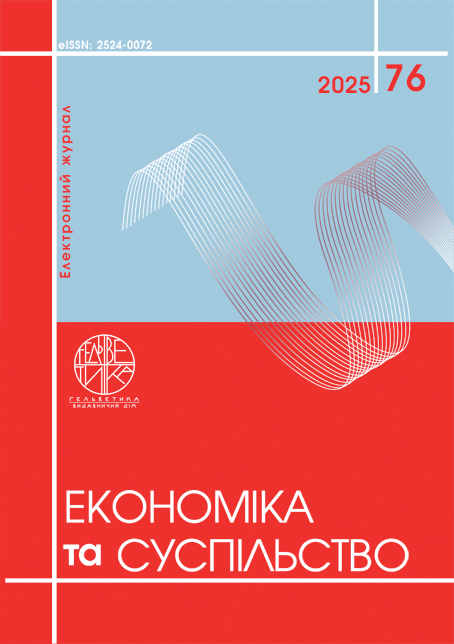«GREEN» ENERGY TRANSITION AS A DRIVER OF A LOW-CARBON ECONOMY: THE EU EXPERIENCE
Abstract
The article explores the essence and key drivers of the «green» energy transition in the European Union, with a particular focus on the decarbonization of the electricity sector as a foundation for a low-carbon economy. The relevance of the topic stems from Ukraine’s urgent need to align its energy policy with EU requirements, especially in the context of integration into ENTSO-E and the implementation of the Carbon Border Adjustment Mechanism (CBAM). The aim of the study is to systematize European practices of electricity decarbonization and substantiate recommendations for their adaptation in Ukraine. The research methodology involves structural-logical analysis, comparative analysis, graphical and SWOT analysis to identify the strengths and weaknesses of the national system, as well as threats and opportunities for green transformation. The results reveal that the main drivers of the EU’s energy transition include the interplay of political support at the EU institutional level, technological modernization of generation infrastructure, targeted financial instruments, and the implementation of transparent climate regulation mechanisms, including greenhouse gas emissions reporting standards. An analytical review of the dynamics of renewable energy development in the EU during 2004–2023 is provided, highlighting the key technological directions and the structure of renewable electricity generation in 2023. The article summarizes the main policy directions of EU decarbonization and evaluates the effectiveness of respective mechanisms in member states. Based on a SWOT analysis, recommendations for Ukraine are developed, taking into account both the country’s external commitments within the framework of European integration and internal limitations, including price caps on the electricity market, underdeveloped energy storage systems, and fragmented climate regulation. The practical value of this study lies in forming an integrated approach to adapting successful European decarbonization experience to the Ukrainian electricity sector, which can be applied in developing sustainable development strategies, enhancing energy security, and ensuring compliance with international climate obligations.
References
Симоненко О., Циганов С. Концепція низьковуглецевої моделі розвитку економіки: теоретичний вимір механізмів переходу. Вісник Київського національного університету імені Тараса Шевченка. Економіка. 2024. № 1 (224). С. 123–129. DOI: https://doi.org/10.17721/1728-2667.2024/224-1/14
Цапко-Піддубна О. Енергетичний перехід в часи геополітичної нестабільності. Економіка та суспільство. 2022. № 43. DOI: https://doi.org/10.32782/2524-0072/2022-43-34 (дата звернення: 09.07.2025).
Osuma G., Yusuf N. Towards an optimal renewable energy mix for the European Union: Enhancing energy security and sustainability. Journal of the Knowledge Economy. 2025. DOI: https://doi.org/10.1007/s13132-024-02586-5 (date of access: 09.07.2025).
Papadopoulou M., Passalacqua R., di Valdalbero D. R., Steele E. R. Decarbonising the EU power sector: a technological and socio-economic analysis and the role of nuclear. arXiv. 2021. DOI: https://doi.org/10.48550/arXiv.2107.01121 (date of access: 09.07.2025).
Victoria M., Zhu K., Brown T., Andresen G. B., Greiner M. Early decarbonisation of the European energy system pays off. Nature Communications. 2020. Vol. 11. DOI: https://doi.org/10.1038/s41467-020-20015-4 (date of access: 09.07.2025).
Presno M. J., Landajo M., Fernández González P. GHG emissions in the EU-28: A multilevel club convergence study of the Emission Trading System and Effort Sharing Decision mechanisms. Sustainable Production and Consumption. 2021. Vol. 27. P. 998–1009. DOI: https://doi.org/10.1016/j.spc.2021.02.032 (date of access: 09.07.2025).
Dumitrescu D. G., Horobeț A., Tudor C. D., Belașcu L. Renewables and decarbonisation: Implications for energy policy in the European Union. Amfiteatru Economic. 2023. Vol. 25. № 63. P. 345–361. URL: https://www.researchgate.net/publication/371434368_Renewables_and_Decarbonisation_Implications_for_Energy_Policy_in_the_European_Union (date of access: 09.07.2025).
Stachelscheid S., Dutzi A. Almost 10 years of dual reporting of Scope 2: chaos or comparability? Carbon Management. 2025. Article: 2459920. DOI: https://doi.org/10.1080/17583004.2025.2459920 (date of access: 09.07.2025).
Nagaj R., Gajdzik B., Wolniak R., Grebski W. W. The impact of deep decarbonization policy on the level of greenhouse gas emissions in the European Union. Energies. 2024. Vol. 17. № 5. DOI: https://doi.org/10.3390/en17051245 (date of access: 09.07.2025).
Noveiri M. J. S., Shabani M., Kordrostami S. Assessing circular economy performance of OECD countries: A double-frontier multi-period DEA with flexible measures. Renewable Energy. 2025. Vol. 246. DOI: https://doi.org/10.1016/j.renene.2025.122851 (date of access: 09.07.2025).
Sakthimurugan V., Lakshmikanth G., Balaji N., Roopashree R., Kumar D., Devarajan Y. Green hydrogen revolution: Advancing electrolysis, market integration, and sustainable energy transitions towards a net-zero future. Results in Engineering. 2025. Vol. 26. DOI: https://doi.org/10.1016/j.rineng.2025.104849 (date of access: 09.07.2025).
Rizzati M. C. P., Ciola E., Turco E., Bazzana D., Vergalli S. Beyond green preferences: Demand-side and supply-side drivers in the low-carbon transition. Environmental and Resource Economics. 2025. Vol. 88. № 5. P. 1239–1295. DOI: https://doi.org/10.1007/s10640-025-00965-3 (date of access: 09.07.2025).
Yakymchuk A., Rataj M. A. Economic analysis of fossil CO₂ emissions: A European perspective on sustainable development. Energies. 2025. Vol. 18. № 8. DOI: https://doi.org/10.3390/en18082106 (date of access: 09.07.2025).
Steiner B., Münch C., Beckmann M., von der Gracht H. Developing net-zero carbon supply chains in the European manufacturing industry – a multilevel perspective. Supply Chain Management. 2024. Vol. 29. № 7. P. 164–181. DOI: https://doi.org/10.1108/SCM-06-2024-0372 (date of access: 09.07.2025).
EU Electricity Trends. Chapter 2. Ember: website. 2024. URL: https://ember-energy.org/latest-insights/european-electricity-review-2024/eu-electricity-trends/ (date of access: 09.07.2025).
Carbon intensity of energy production. Our World in Data: website. 2023. URL: https://ourworldindata.org/grapher/co2-per-unit-energy (date of access: 09.07.2025).
Share of electricity production from renewables. Our World in Data: website. 2024. URL: https://ourworldindata.org/grapher/share-electricity-renewables (date of access: 09.07.2025).
Ember: Warming’s 2024 share of global power demand rise was covered with fossil fuels. Balkan Green Energy News: website. 2025. URL: https://balkangreenenergynews.com/ember-warmings-2024-share-of-global-power-demand-rise-was-covered-with-fossil-fuels/ (date of access: 09.07.2025).
Renewable energy hits 32% of global electricity in 2024, states Ember report. Energy Monitor: website. 2025. URL: https://www.energymonitor.ai/news/renewable-energy-hits/ (date of access: 09.07.2025).
Renewables made up 44.7% of EU electricity production leading in power generation in 2023. Baltic Wind: website. 2024. URL: https://balticwind.eu/renewables-made-up-44-7-of-eu-electricity-production-leading-in-power-generation-in-2023/ (date of access: 09.07.2025).
Symonenko O., Tsyhanov S. (2024) Kontseptsiia nyzkovuhletsevoi modeli rozvytku ekonomiky: teoretychnyi vymir mekhanizmiv perekhodu [The concept of a low-carbon model of economic development: a theoretical dimension of transition mechanisms]. Visnyk Kyivskoho natsionalnoho universytetu imeni Tarasa Shevchenka. Ekonomika, vol. 1, no. 224, pp. 123–129. DOI: https://doi.org/10.17721/1728-2667.2024/224-1/14 (in Ukrainian).
Tsapko-Piddubna O. (2022) Enerhetychnyi perekhid v chasy heopolitychnoi nestabilnosti [Energy transition in times of geopolitical instability]. Ekonomika ta suspilstvo, no 43. DOI: https://doi.org/10.32782/2524-0072/2022-43-34 (in Ukrainian) (accessed July 9, 2025).
Osuma G., Yusuf N. (2025) Towards an optimal renewable energy mix for the European Union: Enhancing energy security and sustainability. Journal of the Knowledge Economy. DOI: https://doi.org/10.1007/s13132-024-02586-5 (accessed July 9, 2025).
Papadopoulou M., Passalacqua R., di Valdalbero D. R., Steele E. R. (2021) Decarbonising the EU power sector: a technological and socio-economic analysis and the role of nuclear. arXiv. DOI: https://doi.org/10.48550/arXiv.2107.01121 (accessed July 9, 2025).
Victoria M., Zhu K., Brown T., Andresen G.B., Greiner M. (2020) Early decarbonisation of the European energy system pays off. Nature Communications, vol. 11. DOI: https://doi.org/10.1038/s41467-020-20015-4 (accessed July 9, 2025).
Presno M. J., Landajo M., Fernández González P. (2021) GHG emissions in the EU-28: A multilevel club convergence study of the Emission Trading System and Effort Sharing Decision mechanisms. Sustainable Production and Consumption, vol. 27, pp. 998–1009. DOI: https://doi.org/10.1016/j.spc.2021.02.032 (accessed July 9, 2025).
Dumitrescu D. G., Horobeț A., Tudor C. D., Belașcu L. (2023) Renewables and decarbonisation: Implications for energy policy in the European Union. Amfiteatru Economic, vol. 25, no. 63, pp. 345–361. Available at: https://www.researchgate.net/publication/371434368_Renewables_and_Decarbonisation_Implications_for_Energy_Policy_in_the_European_Union (accessed July 9, 2025).
Stachelscheid S., Dutzi A. (2025) Almost 10 years of dual reporting of Scope 2: chaos or comparability? Carbon Management, 2459920. DOI: https://doi.org/10.1080/17583004.2025.2459920 (accessed July 9, 2025).
Nagaj R., Gajdzik B., Wolniak R., Grebski W. W. (2024) The impact of deep decarbonization policy on the level of greenhouse gas emissions in the European Union. Energies, vol. 17, no. 5. DOI: https://doi.org/10.3390/en17051245 (accessed July 9, 2025).
Noveiri M. J. S., Shabani M., Kordrostami S. (2025) Assessing circular economy performance of OECD countries: A double-frontier multi-period DEA with flexible measures. Renewable Energy, vol. 246. DOI: https://doi.org/10.1016/j.renene.2025.122851 (accessed July 9, 2025).
Sakthimurugan V., Lakshmikanth G., Balaji N., Roopashree R., Kumar D., Devarajan Y. (2025) Green hydrogen revolution: Advancing electrolysis, market integration, and sustainable energy transitions towards a net-zero future. Results in Engineering, vol. 26. DOI: https://doi.org/10.1016/j.rineng.2025.104849 (accessed July 9, 2025).
Rizzati M.C.P., Ciola E., Turco E., Bazzana D., Vergalli S. (2025) Beyond green preferences: Demand-side and supply-side drivers in the low-carbon transition. Environmental and Resource Economics, vol. 88, no. 5, pp. 1239–1295. DOI: https://doi.org/10.1007/s10640-025-00965-3 (accessed July 9, 2025).
Yakymchuk A., Rataj M. A. (2025) Economic analysis of fossil CO₂ emissions: A European perspective on sustainable development. Energies, vol. 18, no. 8. DOI: https://doi.org/10.3390/en18082106 (accessed July 9, 2025).
Steiner B., Münch C., Beckmann M., von der Gracht H. (2024) Developing net-zero carbon supply chains in the European manufacturing industry – A multilevel perspective. Supply Chain Management, vol. 29, no. 7, pp. 164–181. DOI: https://doi.org/10.1108/SCM-06-2024-0372 (accessed July 9, 2025).
EU Electricity Trends. Chapter 2 (2024) Ember: website. Available at: https://ember-energy.org/latest-insights/european-electricity-review-2024/eu-electricity-trends/ (accessed July 9, 2025).
Carbon intensity of energy production (2023) Our World in Data: website. Available at: https://ourworldindata.org/grapher/co2-per-unit-energy (accessed July 9, 2025).
Share of electricity production from renewables (2024) Our World in Data: website. Available at: https://ourworldindata.org/grapher/share-electricity-renewables (accessed July 9, 2025).
Ember: Warming’s 2024 share of global power demand rise was covered with fossil fuels (2025) Balkan Green Energy News: website. Available at: https://balkangreenenergynews.com/ember-warmings-2024-share-of-global-power-demand-rise-was-covered-with-fossil-fuels/ (accessed July 9, 2025).
Renewable energy hits 32% of global electricity in 2024, states Ember report (2025) Energy Monitor: website. Available at: https://www.energymonitor.ai/news/renewable-energy-hits/ (accessed July 9, 2025).
Renewables made up 44.7% of EU electricity production leading in power generation in 2023 (2024) Baltic Wind: website. Available at: https://balticwind.eu/renewables-made-up-44-7-of-eu-electricity-production-leading-in-power-generation-in-2023/ (accessed July 9, 2025).
Copyright (c) 2025 Андрій Глущенко

This work is licensed under a Creative Commons Attribution 4.0 International License.


